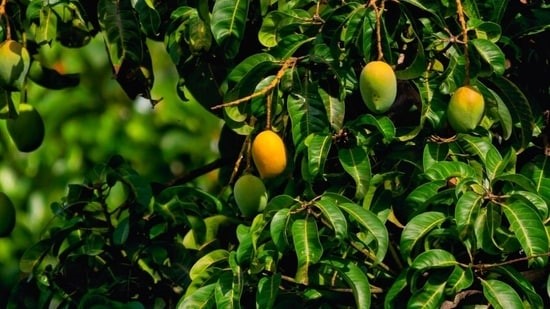Description

Source: HindustanTimes
Disclaimer: Copyright infringement not intended.
Context
- The Food Safety and Standards Authority of India (FSSAI) has issued a directive emphasizing strict compliance with the prohibition on the use of calcium carbide for artificial ripening of fruits.
- This advisory is particularly pertinent during the mango season.
- FSSAI has also instructed the Food Safety Departments of States and Union Territories to be vigilant and take stringent actions against violators.
Details
Key Points
- Health Risks of Calcium Carbide:
- Harmful Substances:Calcium carbide releases acetylene gas containing harmful traces of arsenic and phosphorus.
- Health Issues:Exposure can cause dizziness, frequent thirst, irritation, weakness, difficulty in swallowing, vomiting, and skin ulcers.
- Hazardous Handling:Acetylene gas is dangerous for those handling it, with the risk of direct contact leaving toxic residues on fruits.
- Regulatory Framework:
- Prohibition:Regulation 2.3.5 of the Food Safety and Standards (Prohibition and Restrictions on Sales) Regulations, 2011, bans the sale of fruits ripened with acetylene gas.
- Legal Compliance:Traders and food business operators are required to ensure their practices comply with these regulations to avoid legal repercussions.
- Approved Alternatives:
- Ethylene Gas:FSSAI endorses ethylene gas as a safer alternative for ripening fruits, permissible up to 100 ppm concentration.
- Natural Ripening Process:Ethylene is a naturally occurring hormone that regulates and initiates the ripening process, ensuring safety and uniformity.
- Ethephon 39% SL:Approved by the Central Insecticides Board and Registration Committee for the uniform ripening of mangoes and other fruits.

Calcium Carbide
Chemical Composition and Structure:
- Chemical Formula:CaC₂
- Molecular Weight:10 g/mol
- Appearance:Calcium carbide is a solid compound that is often grayish or black, with a crystalline structure.
Production and Synthesis:
- Calcium carbide is primarily produced in an electric arc furnace from a mixture of lime (CaO) and coke (carbon).
- The chemical reaction can be summarized as follows: CaO+3C→CaC2+COCaO+3C→CaC2+CO
Physical Properties:
- Melting Point:2,300°C (4,172°F)
- Boiling Point:Sublimates at 2,300°C
- Density:22 g/cm³
- Solubility:Reacts with water.
Chemical Properties:
- Reactivity:Calcium carbide reacts vigorously with water, producing acetylene gas (C₂H₂) and calcium hydroxide (Ca(OH)₂): CaC2+2H2O→C2H2+Ca(OH)2CaC2+2H2O→C2H2+Ca(OH)2
- Combustibility:The acetylene gas produced from calcium carbide is highly flammable and used as a fuel in welding and cutting.
Uses and Applications:
- Acetylene Production: The primary use of calcium carbide is in the production of acetylene gas, which is used for welding and cutting metals, as well as in organic synthesis.
- Chemical Industry: Calcium carbide is used as a raw material in the production of chemicals like vinyl chloride (for PVC production), calcium cyanamide (a fertilizer and herbicide), and various organic compounds.
- Ripening of Fruits: In some regions, calcium carbide is used to artificially ripen fruits. However, this practice is controversial and often illegal due to health risks associated with impurities in commercial-grade calcium carbide.
- Steelmaking: Calcium carbide is used in the desulfurization of iron (pig iron) and in the removal of sulfur impurities in steel production.
- Carbide Lamps: Historically, calcium carbide was used in carbide lamps, where water dripped on carbide to produce acetylene gas, which was then ignited for illumination. This application was common in mining and caving before the advent of electric lamps.
Considerations:
- Hazardous Reactions: Calcium carbide should be handled with care, as it reacts with moisture to produce flammable acetylene gas. Storage should be in dry, sealed containers.
- Toxicity: Commercial-grade calcium carbide can contain harmful impurities such as phosphine and arsine gases, which pose health risks.
- Regulations: The use of calcium carbide for fruit ripening is regulated in many countries due to potential health hazards.
- Production Emissions: The production of calcium carbide involves high-energy consumption and the emission of carbon monoxide (CO), a harmful greenhouse gas.
- Waste Management: By-products like calcium hydroxide from the hydrolysis of calcium carbide need proper disposal or utilization to prevent environmental contamination.
Sources:
HindustanTimes
|
PRACTICE QUESTION
Q. Consider the following statements:
- Calcium carbide can leave residues of arsenic and phosphorus on fruits when used for artificial ripening.
- The Food Safety and Standards Authority of India (FSSAI) allows the use of calcium carbide for ripening fruits under strict regulations.
- Ethephon is an approved chemical for the uniform ripening of mangoes and other fruits in India.
Which of the statements given above is/are correct?
a) 1 and 2 only
b) 1 and 3 only
c) 2 and 3 only
d) 1, 2, and 3
Answer: b)
|
















